History
Creation and organisation
Formerly created on 16 March 1792 and numbering 1,200 infantry and 600 cavalry, the Constitutional Guard provided a substantial force expected to ensure the security of the constitutional monarchy in the event of any uprising in Paris. [2] It was recruited from a mixture of regular soldiers with good service records and selected volunteers. Members of the former Régiment des Gardes Françaises (which had mutinied immediately before the storming of the Bastille) were specifically excluded from the new corps. [3]
The commanding officer of the Constitutional Guard was the Duc de Brissac, formerly commander of the Cent-Suisses company of Swiss bodyguards and noted for his personal loyalty to the king. [4] The new force was stationed in and near to the Tuileries palace. Queen Marie-Antoinette had asked that it be uniformed in sky-blue but the conservative politician Antoine Barnave was able to persuade her that this apparently minor measure would lead to confusion with the German mercenary regiments of the former Royal Army. The Constitutional Guard was accordingly issued with the dark blue coats of the French National Guard. [5]
The Guard was organised into two infantry battalions, and 3 cavalry squadrons, known simply as the "Mounted" and "Foot" sections.
Unpopularity
Although the new corps had been organised and sworn in according to the requirements of the Constitution of September 1791, it almost immediately became the object of suspicion and hostility by the growing revolutionary movement. There were street brawls between guardsmen and anti-monarchists, and revolutionary newspapers inaccurately described the Constitutional Guard as being made up of aristocrats. [6] This appears to have been an attempt to link the new guard with its predecessor - the recently disbanded Gardes du Corps, which had been recruited solely from members of the nobility.
Dissolution
On 29 May 1792 the Constitutional Guard was disbanded. This measure was undertaken following a formal request from the Legislative Assembly addressed to King Louis, whose position had been weakened following the abortive flight to Varennes. He hoped, by concurring in the dissolution of his guard, to win support for several vetoes that he wished to impose. These related to measures aimed at the deportation of refractory priests and the establishment of a military camp for provincial militias near Paris. [7]
The Constitutional Guard was replaced by units of the Paris National Guard, who took over responsibility for the security of the Tuileries palace and the royal family resident there. Lacking any particular commitment of loyalty to the monarchy, the National Guard was to prove unreliable when the Tuileries was finally stormed by revolutionary forces on 10 August 1792. The Duc de Brissac was arrested on charges of planning to use his guardsmen against the Assembly, and subsequently killed during the September Massacres that followed.

Swiss Guards are Swiss soldiers who have served as guards at foreign European courts since the late 15th century.

The royal Flight to Varennes during the night of 20–21 June 1791 was a significant event in the French Revolution in which King Louis XVI of France, Queen Marie Antoinette, and their immediate family unsuccessfully attempted to escape from Paris to Montmédy, where the King wished to initiate a counter-revolution by joining up with royalist troops. They escaped as far as the small town of Varennes-en-Argonne, where they were arrested after being recognized at their previous stop in Sainte-Menehould.

Louis Philippe II, Duke of Orléans, was a French Prince of the Blood who supported the French Revolution.
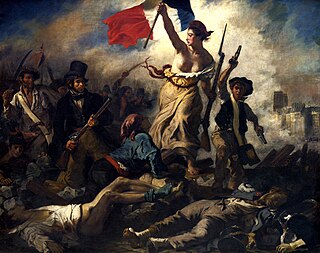
The French Revolution of 1830, also known as the July Revolution, Second French Revolution, or Trois Glorieuses, was a second French Revolution after the first in 1789. It led to the overthrow of King Charles X, the French Bourbon monarch, and the ascent of his cousin Louis Philippe, Duke of Orléans. After 18 precarious years on the throne, Louis-Philippe was overthrown in the French Revolution of 1848.

The National Guard is a French military, gendarmerie, and police reserve force, active in its current form since 2016 but originally founded in 1789 during the French Revolution.

The insurrection of 10 August 1792 was a defining event of the French Revolution, when armed revolutionaries in Paris, increasingly in conflict with the French monarchy, stormed the Tuileries Palace. The conflict led France to abolish the monarchy and establish a republic.

The term "fédérés" most commonly refers to the troops who volunteered for the French National Guard in the summer of 1792 during the French Revolution. The fédérés of 1792 effected a transformation of the Guard from a constitutional monarchist force into a republican revolutionary force.
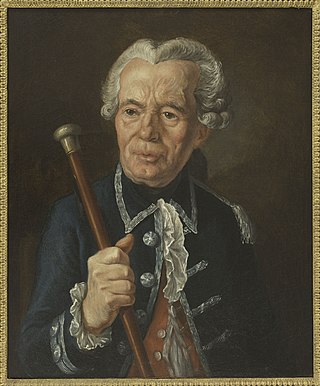
Bernard René Jourdan, marquis de Launay was the French governor of the Bastille. He was the son of a previous governor, and commander of the Bastille's garrison when the prison-fortress in Paris was stormed on 14 July 1789.

The French Guards were an elite infantry regiment of the French Royal Army. They formed a constituent part of the maison militaire du roi de France under the Ancien Régime.

The Women's March on Versailles, also known as the October March, the October Days or simply the March on Versailles, was one of the earliest and most significant events of the French Revolution. The march began among women in the marketplaces of Paris who, on the morning of 5 October 1789, were nearly rioting over the high price of bread. The unrest quickly became intertwined with the activities of revolutionaries seeking liberal political reforms and a constitutional monarchy for France. The market women and their allies ultimately grew into a crowd of thousands. Encouraged by revolutionary agitators, they ransacked the city armory for weapons and marched on the Palace of Versailles. The crowd besieged the palace and, in a dramatic and violent confrontation, they successfully pressed their demands upon King Louis XVI. The next day, the crowd forced the king and his family to return with them to Paris. Over the next few weeks most of the French Assembly also relocated to the capital.

The Cent-Suisses were an elite infantry company of Swiss mercenaries that served the French kings from 1471 to 1792 and from 1814 to 1830.

The Gardes du Corps du Roi was the senior formation of the King of France's household cavalry within the maison militaire du roi de France.
A Colonel General was an officer of the French army during the Ancien Régime, the French Revolution, the Napoleonic era and the Bourbon Restoration.
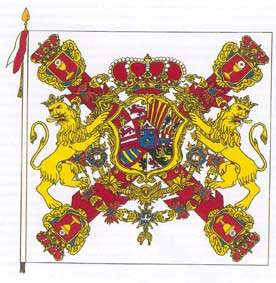
The Walloon Guards were an infantry corps recruited for the Spanish Army in the region now known as Belgium, mainly from Catholic Wallonia. As foreign troops without direct ties amongst the Spanish population, the Walloons were often tasked with the maintenance of public order, eventually being incorporated as a regiment of the Spanish Royal Guard.
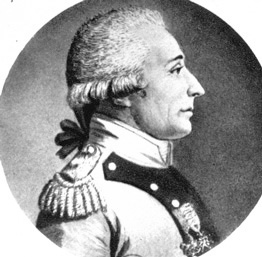
Louis Charles Le Cat, comte d'Hervilly was a French nobleman, military officer and counter-revolutionary. He was one of the leaders of the abortive landing at Quiberon. His daughter married the general Marie-François Auguste de Caffarelli du Falga.
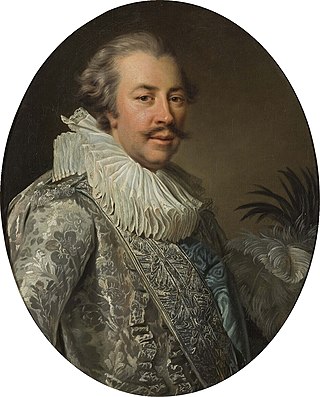
Louis Hercule Timoléon de Cossé, 8th Duke of Brissac, was a French military commander and peer of France. He was the second son and eventual heir of Jean Paul Timoléon de Cossé, 7th Duke of Brissac, who was a Marshal of France.

Antoine Jean Galiot Mandat, known as the Marquis de Mandat, was a French nobleman, general and politician. A knight and lord of Berny-en-Santerre and Les Pins in the Vendômois, he became a colonel in the Gardes-Françaises, then succeeded La Fayette as commander of the National Guard in 1792. He was assassinated by insurgents in the insurrection of 10 August during the French Revolution.

The maison militaire du roi de France, in English the military household of the king of France, was the military part of the French royal household or Maison du Roi under the Ancien Régime. The term only appeared in 1671, though such a gathering of units pre-dates this. Like the rest of the royal household, the military household was under the authority of the Secretary of State for the Maison du Roi. Still, it depended on the ordinaire des guerres for its budget. Under Louis XIV, these two officers of state were given joint command of the military household.

The Nancy affair, commonly referred to in English as the Nancy Mutiny, was the crushing of a military mutiny in France on 31 August 1790, two years before the final overthrow of the French monarchy. The mutiny was of particular significance in that it illustrated the degree to which the discipline and reliability of the Royal Army had been undermined by thirteen months of revolutionary turmoil.

The Kingdom of France was a constitutional monarchy from 3 September 1791 until 21 September 1792, when it was succeeded by the French First Republic.
























